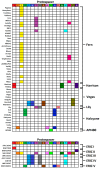Characterization of CRISPR Spacer and Protospacer Sequences in Paenibacillus larvae and Its Bacteriophages
- PMID: 33799666
- PMCID: PMC7998209
- DOI: 10.3390/v13030459
Characterization of CRISPR Spacer and Protospacer Sequences in Paenibacillus larvae and Its Bacteriophages
Abstract
The bacterium Paenibacillus larvae is the causative agent of American foulbrood, the most devastating bacterial disease of honeybees. Because P. larvae is antibiotic resistant, phages that infect it are currently used as alternative treatments. However, the acquisition by P. larvae of CRISPR spacer sequences from the phages could be an obstacle to treatment efforts. We searched nine complete genomes of P. larvae strains and identified 714 CRISPR spacer sequences, of which 384 are unique. Of the four epidemiologically important P. larvae strains, three of these have fewer than 20 spacers, while one strain has over 150 spacers. Of the 384 unique spacers, 18 are found as protospacers in the genomes of 49 currently sequenced P. larvae phages. One P. larvae strain does not have any protospacers found in phages, while another has eight. Protospacer distribution in the phages is uneven, with two phages having up to four protospacers, while a third of phages have none. Some phages lack protospacers found in closely related phages due to point mutations, indicating a possible escape mechanism. This study serve a point of reference for future studies on the CRISPR-Cas system in P. larvae as well as for comparative studies of other phage-host systems.
Keywords: American foulbrood; CRISPR; Paenibacillus larvae; bacterial immunity; phages; protospacers; spacers.
Conflict of interest statement
The authors declare no conflict of interest.
Figures



Similar articles
-
Paenibacillus larvae bacteriophages: obscure past, promising future.Microb Genom. 2020 Feb;6(2):e000329. doi: 10.1099/mgen.0.000329. Microb Genom. 2020. PMID: 32111267 Free PMC article. Review.
-
Genomic Analysis of 48 Paenibacillus larvae Bacteriophages.Viruses. 2018 Jul 19;10(7):377. doi: 10.3390/v10070377. Viruses. 2018. PMID: 30029517 Free PMC article.
-
Isolation and Characterization of Phages Active against Paenibacillus larvae Causing American Foulbrood in Honeybees in Poland.Viruses. 2021 Jun 23;13(7):1217. doi: 10.3390/v13071217. Viruses. 2021. PMID: 34201873 Free PMC article.
-
Abundant and diverse clustered regularly interspaced short palindromic repeat spacers in Clostridium difficile strains and prophages target multiple phage types within this pathogen.mBio. 2014 Aug 26;5(5):e01045-13. doi: 10.1128/mBio.01045-13. mBio. 2014. PMID: 25161187 Free PMC article.
-
Biology of Paenibacillus larvae, a deadly pathogen of honey bee larvae.Appl Microbiol Biotechnol. 2016 Sep;100(17):7387-95. doi: 10.1007/s00253-016-7716-0. Epub 2016 Jul 9. Appl Microbiol Biotechnol. 2016. PMID: 27394713 Review.
Cited by
-
Paenibacillus larvae and their phages; a community science approach to discovery and initial testing of prophylactic phage cocktails against American Foulbrood in New Zealand.Microbiome Res Rep. 2023 Aug 1;2(4):30. doi: 10.20517/mrr.2023.16. eCollection 2023. Microbiome Res Rep. 2023. PMID: 38045927 Free PMC article.
-
In Vitro Evolution to Increase the Titers of Difficult Bacteriophages: RAMP-UP Protocol.Phage (New Rochelle). 2023 Jun 1;4(2):68-81. doi: 10.1089/phage.2023.0005. Epub 2023 Jun 19. Phage (New Rochelle). 2023. PMID: 37350994 Free PMC article.
-
Escherichia coli CRISPR arrays from early life fecal samples preferentially target prophages.ISME J. 2024 Jan 8;18(1):wrae005. doi: 10.1093/ismejo/wrae005. ISME J. 2024. PMID: 38366192 Free PMC article.
-
Genomic Analysis of 96 Paenibacillus larvae Bacteriophages Including 26 from Aotearoa, New Zealand.Viruses. 2025 Jan 21;17(2):137. doi: 10.3390/v17020137. Viruses. 2025. PMID: 40006892 Free PMC article.
-
Bacteriophage resistance evolution in a honey bee pathogen.bioRxiv [Preprint]. 2025 Jan 31:2024.07.09.602782. doi: 10.1101/2024.07.09.602782. bioRxiv. 2025. Update in: Microbiology (Reading). 2025 Aug;171(8). doi: 10.1099/mic.0.001595. PMID: 39026776 Free PMC article. Updated. Preprint.
References
-
- Yue D., Nordhoff M., Wieler L.H., Genersch E. Fluorescence in situ hybridization (FISH) analysis of the interactions between honeybee larvae and Paenibacillus larvae, the causative agent of American foulbrood of honeybees (Apis mellifera) Environ. Microbiol. 2008;10:1612–1620. doi: 10.1111/j.1462-2920.2008.01579.x. - DOI - PubMed
-
- Lindström A., Korpela S., Fries I. The distribution of Paenibacillus larvae spores in adult bees and honey and larval mortality, following the addition of American foulbrood diseased brood or spore-contaminated honey in honey bee (Apis mellifera) colonies. J. Invertebr. Pathol. 2008;99:82–86. doi: 10.1016/j.jip.2008.06.010. - DOI - PubMed
-
- Genersch E., Forsgren E., Pentikäinen J., Ashiralieva A., Rauch S., Kilwinski J., Fries I. Reclassification of Paenibacillus larvae subsp. pulvifaciens and Paenibacillus larvae subsp. larvae as Paenibacillus larvae without subspecies differentiation. Int. J. Syst. Evol. Microbiol. 2006;56:501–511. - PubMed
MeSH terms
Substances
LinkOut - more resources
Full Text Sources
Other Literature Sources
Molecular Biology Databases

